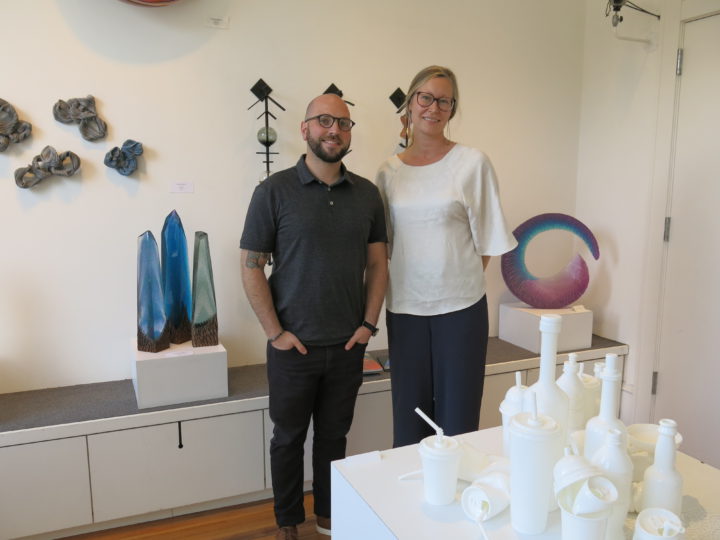Regional artist Alex Gabriel Bernstein remembers dinner parties at his childhood home in Spruce Pine. Because his parents were glassblowers with ties to the Penland School of Crafts, guests usually consisted of fellow makers, gallery owners and collectors. On one occasion, Bernstein recalls, Dale Chihuly and Harvey Littleton were among those at the table.
Whether you’re an art connoisseur, neophyte or philistine, there’s a good chance the name Chihuly rings a bell. No? Think giant glass sculptures currently on exhibit at the Biltmore Estate. (See, we knew you’d recognize him!)
The name Littleton, however, might not be as familiar to those outside the art world. This gap in knowledge has a tinge of irony when you discover that Littleton (who taught Chihuly at the University of Wisconsin at Madison) is considered the “Father of Studio Glass.” He’s also one of the major reasons Western North Carolina continues to be held in high regard by those within the glass world.
“I think of it as a three-legged stool,” explains Bernstein, in discussing the region’s prestige and appeal to glassmakers: “There’s Harvey, Penland School and the natural beauty of the area.”
Candace Reilly, assistant director at Blue Spiral 1, puts it more bluntly. “Without Harvey Littleton, we wouldn’t be on the map at all,” she says.
Of course, Littleton’s impact stretches far beyond the mountains of WNC. In 1962, he and glass research scientist Dominick Labino led the country’s first two glassblowing workshops at The Toledo Museum of Art in Toledo, Ohio. Prior to these courses, glasswork was considered an industrial practice, confined to factories.
“What Harvey did was democratize studio glass,” says Denise Drury Homewood, executive director of the Western Carolina University Fine Art Museum. “He was a huge proponent of sharing that knowledge.”

Throughout the 1960s, Littleton encouraged students to branch out and begin new programs as a way to further spread glasswork across the country. “A lot of people very much doubted that it could be done, because it was such a contrast to what they were used to,” says Littleton’s biographer, Joan Falconer Byrd. “Harvey himself had to work very hard to publicize what he was doing, and he did a lot of traveling, but he was tireless.”
In 1965, Littleton’s former pupil Bill Boysen built the Penland School of Crafts’ first glass studio. By 1971, Penland students Mark Peiser, Fritz Dreisbach and William Bernstein formed the Glass Art Society. Today, the nonprofit is an international organization that seeks to encourage excellence, advance education and promote the appreciation and development of the glass arts.
Upon his retirement in 1977, Littleton left Wisconsin for Spruce Pine, where several of his colleagues and friends worked and taught. According to Littleton’s son, John, the area’s strong glass art community was a deciding factor in his father’s move. And with Littleton’s arrival to the area, Spruce Pine’s reputation as a hub for glasswork continued to grow.
Artist Kate Vogel notes that even after Littleton’s death in 2013, the region’s tight-knit community continues to this day. “I definitely think that’s something that sets us apart” from other areas, she says. “We can call up dozens of artists on any subject, from equipment use … to information about certain galleries … and we always have affirmative support.”
Fellow maker and former Penland resident Dean Allison agrees. He has worked with and studied the glass medium throughout the country and across the world, including stints in Australia and England. “The unique thing about Western North Carolina is the community,” he says. “You have this sense of family and togetherness and people who are helping each other out. That’s not found everywhere.”
Part of the region’s bond, notes Michael Manes, gallery director at Blue Spiral 1, lies in the fact that many of the WNC glass artists are second- or third-generation makers. Within the downtown Asheville gallery’s current exhibit, Glass Takeover, three of the featured artists fall into this category: Alex Bernstein, John Littleton and Hayden Wilson. Such a lineage, says Manes, “speaks to the importance of teaching and the handing down of information” within the medium.
Along with their reverence for the past, the area’s glassmakers remain proactive and optimistic about the region’s future role within the larger glass world. From the North Carolina Glass Center to Jackson County Green Energy Park, from Blue Spiral 1 to Momentum Gallery, artists say the area’s infrastructure and support system is strong.

The studio glass movement is also still quite young, points out Bernstein, who believes new techniques could be discovered. Meanwhile, current methods continue to fascinate those in the field. “Glass is kind of like magic,” Bernstein asserts, noting the wonder that accompanies the transformation of sand particles to works of art.
For Byrd, a similar energy and sense of awe existed in Littleton’s own personality and quest to bring glass to the masses. “He was absolutely passionate about what he did and he was a rebel. There was really no way of holding him back once he got going on something,” she says.
“From the beginning, Harvey wanted to start a whole field,” Byrd continues. “And he just really wanted to inspire a group of students blowing glass so that there would be a field with suppliers and galleries and museums and all that. And it has all happened, absolutely wonderfully.”



With the recent announcement of “genius grants” from the MacArthur Foundation, I’m curious if Harvey LIttleton would have ever been considered for this award/honor? Most of the current recipients (with the exception of Rev. Barbour, are clearly “establishment” figures, from New York, the big-name universities, the big California culture centers. Do the creatives of Asheville ever get considered? Who would (should?) be on our “genius grant” nomination list?